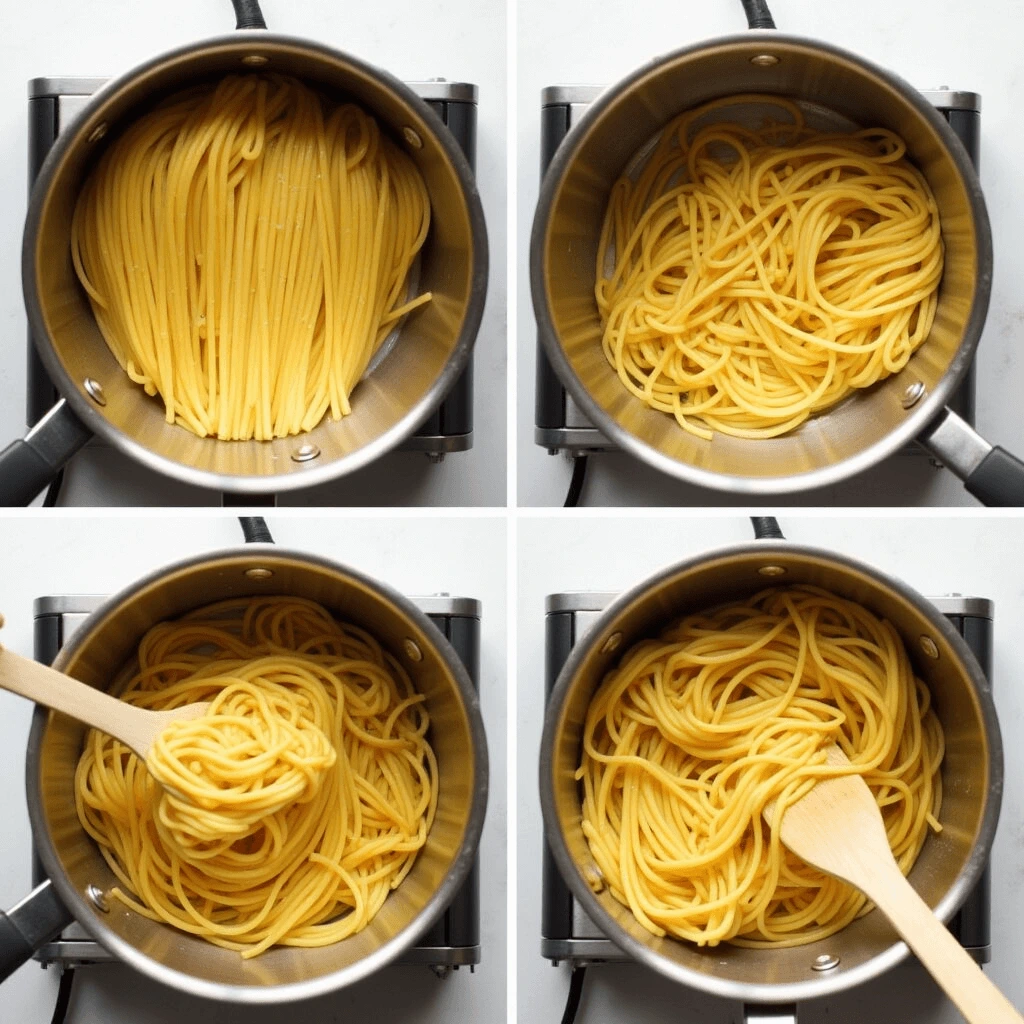Cooking spaghetti might seem simple, but mastering the process is the key to achieving perfect texture and rich flavor every time. From boiling the pasta just right to knowing when to salt the water and how to blend your sauce, each step matters. Whether you’re preparing a quick weeknight meal or impressing guests with a classic Italian dinner, understanding the proper cooking techniques can make all the difference. In this section, you’ll learn the essential steps and expert tips to ensure your spaghetti turns out perfectly—never sticky, never overcooked, and always delicious.
Mastering the Cooking Process for Perfect Spaghetti
For detailed guidance on cooking spaghetti perfectly every time, check out The Kitchen’s Ultimate Guide to Cooking Pasta.
How to boil spaghetti al dente: timing and salt tips
Cooking spaghetti al dente—Italian for “to the tooth”—means the pasta is tender but still has a slight bite in the center. This texture isn’t just about preference; it actually enhances the overall eating experience by holding up better in sauces and improving digestion. Here’s how to get it just right:
1. Use Plenty of Water
Start with a large pot and fill it with plenty of water—about 4 to 6 quarts per pound of spaghetti. This prevents the noodles from sticking together and allows them to cook evenly. A roomy pot also makes stirring easier, which is key for uniform cooking.
2. Add Salt Generously
Once the water comes to a rolling boil, add salt—about 1 to 1.5 tablespoons per quart of water. The water should taste slightly like the sea. Salt enhances the pasta’s flavor from within as it cooks, so don’t skip this step. Avoid adding oil; it can prevent sauce from sticking to the noodles later.
3. Watch the Timing
Check the package instructions for the recommended cooking time, then subtract one minute. Stir the pasta immediately after adding it to boiling water, and continue stirring occasionally. Begin checking for doneness about 1–2 minutes before the end of the suggested time. Al dente pasta should be firm yet tender when bitten.
4. Taste Test
The best way to know if your spaghetti is al dente is to taste it. Break off a piece and bite into it—it should be cooked through, with a slight resistance in the center. If it feels too firm or has a white core when broken, give it another minute and test again.
5. Reserve Pasta Water
Before draining, scoop out a cup of the starchy pasta water. This can be added to your sauce to help it cling to the spaghetti and create a silky texture.
Using the right kitchen tools: pot, colander, saucepan
The secret to cooking perfect spaghetti isn’t just in the ingredients—it also lies in using the right kitchen tools. Having a few essential items on hand makes the process smoother, faster, and more consistent. Let’s break down the key tools you need and how to use them effectively.
1. Large Pot for Boiling
A deep, heavy-bottomed pot is essential for boiling spaghetti properly. It should be large enough to hold at least 4 to 6 quarts of water, especially if you’re cooking a full pound of pasta. A spacious pot prevents overcrowding, which reduces the risk of noodles sticking together. It also ensures the pasta cooks evenly. A lid helps bring the water to a boil faster and keeps the heat consistent throughout cooking.
Tip: Choose a pot with sturdy handles and a thick base. It holds heat better and is easier to handle when full.
2. Colander for Easy Draining
Once your spaghetti is cooked to al dente perfection, draining it quickly is crucial to prevent overcooking. A good colander with large holes and heat-resistant handles lets you strain the pasta efficiently. Stainless steel colanders are durable and easy to clean, while silicone or mesh options may suit smaller kitchens.
Tip: Place the colander in the sink before draining and always reserve a cup of pasta water beforehand—it’s liquid gold for your sauce!
3. Saucepan or Sauté Pan for Sauce
A sturdy saucepan or wide sauté pan is perfect for preparing your spaghetti sauce. Whether you’re making a simple garlic and olive oil base or a rich tomato blend, even heat distribution is key. A saucepan with a thick bottom helps prevent burning or sticking while simmering. If you plan to toss your spaghetti with the sauce before serving, a wide pan gives you the space to do it properly.
Tip: Combine the cooked spaghetti and sauce in the pan and toss them together over low heat for a minute. This helps the flavors bind and the sauce cling to the noodles.
Avoiding common mistakes like overcooking or sticking noodles
Even the simplest spaghetti recipes can go wrong if you’re not careful with the cooking process. Overcooked or sticky noodles can ruin the texture and flavor of your dish. Fortunately, avoiding these common mistakes is easy once you understand what causes them and how to prevent them.
1. Not Watching the Cooking Time
One of the most common mistakes is overcooking the spaghetti. Pasta that is too soft or mushy lacks the satisfying bite of al dente and can become gluey. Always read the package instructions and set a timer. Begin tasting the pasta at least 2 minutes before the suggested cook time ends. You’re aiming for a firm texture with a slight resistance in the center.
Pro Tip: Drain the pasta the moment it reaches al dente—it will continue to soften slightly from residual heat even after draining.
2. Starting with Cold or Insufficient Water
Adding pasta to cold or lukewarm water prevents it from cooking evenly and increases the chances of sticking. Always bring a full pot of water to a rolling boil before adding spaghetti. Make sure there’s enough water (4–6 quarts per pound of pasta) to allow the noodles to move freely.
3. Forgetting to Stir
Spaghetti can stick together if you don’t stir it during the first minute or two of cooking. Stirring helps separate the noodles as they soften and prevents them from clumping.
Pro Tip: Stir the pasta right after you drop it into the boiling water and give it a few more stirs throughout cooking.
4. Skipping the Salt
Some people skip salting their pasta water, either to reduce sodium or simply by habit. However, unsalted water leads to bland noodles. Salting the water not only enhances flavor but also helps prevent sticking.
Suggested Ratio: Use 1 to 1.5 tablespoons of salt per quart of water.
5. Rinsing the Pasta After Cooking
Rinsing spaghetti under cold water washes away the starch that helps the sauce cling to the noodles. Unless you’re preparing a cold pasta salad, never rinse your pasta after draining.
Instead: Toss the hot pasta directly with your sauce or a bit of olive oil if you’re not serving it immediately.

